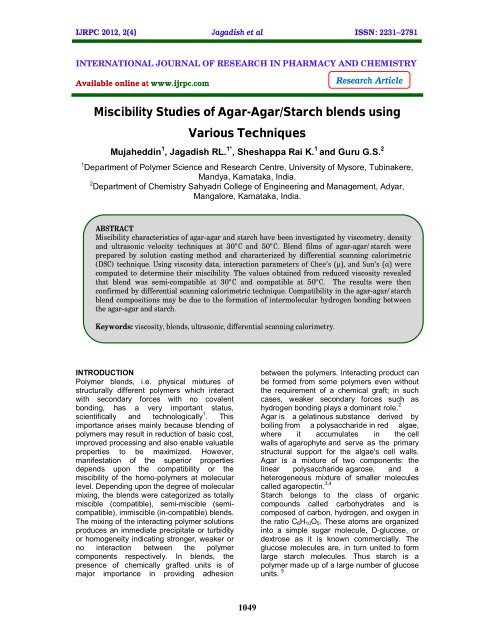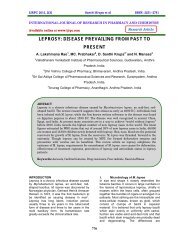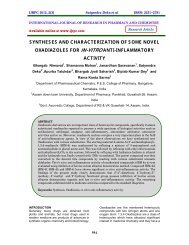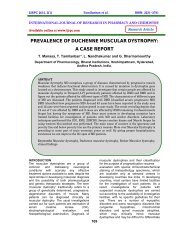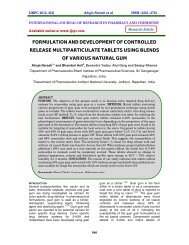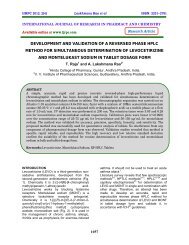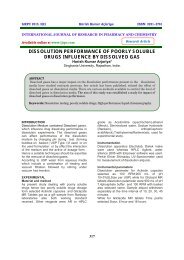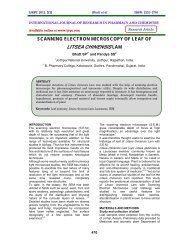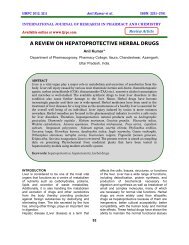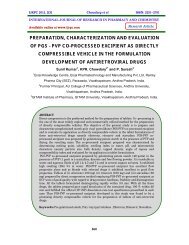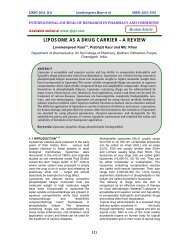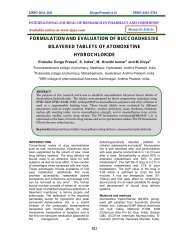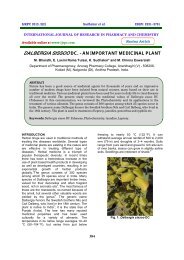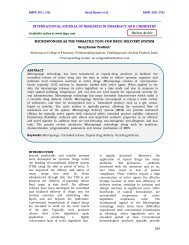Miscibility Studies of Agar-Agar/Starch blends using Various ... - ijrpc
Miscibility Studies of Agar-Agar/Starch blends using Various ... - ijrpc
Miscibility Studies of Agar-Agar/Starch blends using Various ... - ijrpc
You also want an ePaper? Increase the reach of your titles
YUMPU automatically turns print PDFs into web optimized ePapers that Google loves.
IJRPC 2012, 2(4) Jagadish et al ISSN: 22312781<br />
INTERNATIONAL JOURNAL OF RESEARCH IN PHARMACY AND CHEMISTRY<br />
Available online at www.<strong>ijrpc</strong>.com<br />
Research Article<br />
<strong>Miscibility</strong> <strong>Studies</strong> <strong>of</strong> <strong>Agar</strong>-<strong>Agar</strong>/<strong>Starch</strong> <strong>blends</strong> <strong>using</strong><br />
<strong>Various</strong> Techniques<br />
Mujaheddin 1 , Jagadish RL. 1* , Sheshappa Rai K. 1 and Guru G.S. 2<br />
1 Department <strong>of</strong> Polymer Science and Research Centre, University <strong>of</strong> Mysore, Tubinakere,<br />
Mandya, Karnataka, India.<br />
2 Department <strong>of</strong> Chemistry Sahyadri College <strong>of</strong> Engineering and Management, Adyar,<br />
Mangalore, Karnataka, India.<br />
ABSTRACT<br />
<strong>Miscibility</strong> characteristics <strong>of</strong> agar-agar and starch have been investigated by viscometry, density<br />
and ultrasonic velocity techniques at 30ºC and 50ºC. Blend films <strong>of</strong> agar-agar/starch were<br />
prepared by solution casting method and characterized by differential scanning calorimetric<br />
(DSC) technique. Using viscosity data, interaction parameters <strong>of</strong> Chee’s (μ), and Sun’s (α) were<br />
computed to determine their miscibility. The values obtained from reduced viscosity revealed<br />
that blend was semi-compatible at 30ºC and compatible at 50ºC. The results were then<br />
confirmed by differential scanning calorimetric technique. Compatibility in the agar-agar/starch<br />
blend compositions may be due to the formation <strong>of</strong> intermolecular hydrogen bonding between<br />
the agar-agar and starch.<br />
Keywords: viscosity, <strong>blends</strong>, ultrasonic, differential scanning calorimetry.<br />
INTRODUCTION<br />
Polymer <strong>blends</strong>, i.e. physical mixtures <strong>of</strong><br />
structurally different polymers which interact<br />
with secondary forces with no covalent<br />
bonding, has a very important status,<br />
scientifically and technologically 1 . This<br />
importance arises mainly because blending <strong>of</strong><br />
polymers may result in reduction <strong>of</strong> basic cost,<br />
improved processing and also enable valuable<br />
properties to be maximized. However,<br />
manifestation <strong>of</strong> the superior properties<br />
depends upon the compatibility or the<br />
miscibility <strong>of</strong> the homo-polymers at molecular<br />
level. Depending upon the degree <strong>of</strong> molecular<br />
mixing, the <strong>blends</strong> were categorized as totally<br />
miscible (compatible), semi-miscible (semicompatible),<br />
immiscible (in-compatible) <strong>blends</strong>.<br />
The mixing <strong>of</strong> the interacting polymer solutions<br />
produces an immediate precipitate or turbidity<br />
or homogeneity indicating stronger, weaker or<br />
no interaction between the polymer<br />
components respectively. In <strong>blends</strong>, the<br />
presence <strong>of</strong> chemically grafted units is <strong>of</strong><br />
major importance in providing adhesion<br />
between the polymers. Interacting product can<br />
be formed from some polymers even without<br />
the requirement <strong>of</strong> a chemical graft; in such<br />
cases, weaker secondary forces such as<br />
hydrogen bonding plays a dominant role. 2<br />
<strong>Agar</strong> is a gelatinous substance derived by<br />
boiling from a polysaccharide in red algae,<br />
where it accumulates in the cell<br />
walls <strong>of</strong> agarophyte and serve as the primary<br />
structural support for the algae's cell walls.<br />
<strong>Agar</strong> is a mixture <strong>of</strong> two components: the<br />
linear polysaccharide agarose, and a<br />
heterogeneous mixture <strong>of</strong> smaller molecules<br />
called agaropectin. 3,4<br />
<strong>Starch</strong> belongs to the class <strong>of</strong> organic<br />
compounds called carbohydrates and is<br />
composed <strong>of</strong> carbon, hydrogen, and oxygen in<br />
the ratio C 6 H 10 O 5 . These atoms are organized<br />
into a simple sugar molecule, D-glucose, or<br />
dextrose as it is known commercially. The<br />
glucose molecules are, in turn united to form<br />
large starch molecules. Thus starch is a<br />
polymer made up <strong>of</strong> a large number <strong>of</strong> glucose<br />
units. 5<br />
1049
IJRPC 2012, 2(4) Jagadish et al ISSN: 22312781<br />
As a part <strong>of</strong> our research program, we have<br />
studied miscibility <strong>of</strong> agar-agar/starch <strong>blends</strong> in<br />
solution and solid state. The purpose <strong>of</strong> this<br />
study is to characterize the miscibility nature <strong>of</strong><br />
the agar-agar and starch <strong>blends</strong>. These homopolymers<br />
are extensively used in food and<br />
pharmaceutical industries. Hence blending <strong>of</strong><br />
these polymers might be enhancing their<br />
properties.<br />
MATERIALS AND METHODS<br />
Polymers used for the present study are agaragar<br />
[Merk, Mumbai, India] and starch [Merk,<br />
Mumbai, India] which are natural products.<br />
Viscometric method is based on the study <strong>of</strong><br />
interaction in dilute solutions <strong>of</strong> two polymers<br />
in common solvent. The total weight <strong>of</strong> the two<br />
components in solution is always maintained<br />
at 0.2g/dL. Stock solutions <strong>of</strong> homo-polymers<br />
agar-agar, starch and their <strong>blends</strong> <strong>of</strong> different<br />
compositions (90/10, 80/20, 70/30, 60/40<br />
50/50, 40/60 30/70, 20/80 and 10/90) were<br />
prepared in distilled water. The relative<br />
viscosities <strong>of</strong> the polymer <strong>blends</strong> are<br />
determined at 30ºC and 50ºC <strong>using</strong><br />
Ubbelohde suspended-level viscometer<br />
(USLV). Different temperatures were<br />
maintained in a thermostat bath with a thermal<br />
stability <strong>of</strong> ± 0.05ºC.<br />
Ultrasonic velocity measurements <strong>of</strong> blend<br />
solution <strong>of</strong> different compositions were<br />
performed by an ultrasonic interferometer<br />
technique 6 . During the experiment, different<br />
temperature (30ºC and 50º C) is maintained by<br />
circulating water from thermostat with a<br />
thermal stability <strong>of</strong> ± 0.05ºC, through the<br />
double walled jacket <strong>of</strong> the ultrasonic<br />
experimental cell. The experimental frequency<br />
was 2MHz.<br />
Differential scanning calorimeter (DSC)<br />
technique is used to detect glass transition<br />
temperature <strong>of</strong> polymer <strong>blends</strong>. The thin films<br />
<strong>of</strong> agar-agar, starch and their <strong>blends</strong> were<br />
prepared by solution casting method. Films<br />
were dried <strong>using</strong> IR Lamp. DSC<br />
measurements were performed in TA Q200<br />
Differential Scanning Calorimeter, under<br />
nitrogen atmosphere. During DSC<br />
measurements, heating/cooling/heating<br />
method was used. In the first cycle <strong>of</strong><br />
measurements, sample was heated to 90ºC<br />
and equilibrated to remove remaining water<br />
content in the sample. The sample was then<br />
cooled to 20ºC and reheated to 250ºC. The<br />
heating/cooling/heating rate was set at<br />
10ºC/min.<br />
RESULTS AND DISCUSSION<br />
Viscometric measurements<br />
From viscometric measurements, reduced<br />
viscosities <strong>of</strong> homo-polymers agar-agar, starch<br />
and their blend compositions (90/10, 80/20,<br />
70/30, 60/40, 50/50, 40/60, 30/70, 20/80 and<br />
10/90) were measured at 30ºC and 50ºC.<br />
Reduced viscosities <strong>of</strong> the pure polymers and<br />
their blend compositions are plotted against<br />
concentration are shown in Figures 1 and 2<br />
respectively.<br />
The Huggin’s plot (Figure 1) <strong>of</strong> agaragar/starch<br />
and their blend compositions at<br />
30ºC is indicating little higher slope values for<br />
80/20, 70/30, 60/40 50/50, 40/60 30/70, 20/80<br />
and 10/90 blend compositions than 90/10<br />
blend <strong>of</strong> agar-agar/starch. This may be<br />
attributed to mutual attraction <strong>of</strong> macro<br />
molecules in solution, which leads to increase<br />
in hydrodynamic volume. 7<br />
At 50ºC Huggin’s plot (Figure 2) <strong>of</strong> agaragar/starch<br />
and their blend compositions<br />
indicating little higher slope value for all the<br />
composition. This is may be due to the effect<br />
<strong>of</strong> temperature on mutual attraction <strong>of</strong> macro<br />
molecule in solution.<br />
To quantify the miscibility <strong>of</strong> polymer <strong>blends</strong>,<br />
Chee 8 suggested the general expression for<br />
interaction parameter when the polymers are<br />
mixed in weight fractions w 1 and w 2 as<br />
where b = w 1 b 11 + w 2 b 22 where b 11 and b 22 are<br />
the slopes <strong>of</strong> the viscosity curves for the<br />
components and b is related to Huggins<br />
coefficient K H as,<br />
where [] is intrinsic viscosity<br />
For ternary system, it is also given by<br />
where b 12 is slope for the blend solution.<br />
However, Chee’s theory fails to account for the<br />
experimental data when intrinsic viscosities <strong>of</strong><br />
pure components are far apart. In such cases<br />
he defined a more efficient parameter to<br />
predict compatibility,<br />
where [] 1 and [] 2 are intrinsic viscosities <strong>of</strong><br />
pure component solutions. The polymer blend<br />
is miscible if 0 and immiscible when < 0.<br />
1050
IJRPC 2012, 2(4) Jagadish et al ISSN: 22312781<br />
Later Sun et al. 9 have suggested a most<br />
satisfactory new equation for the determination<br />
<strong>of</strong> polymer miscibility as<br />
where K 1 , K 2 and K m are the Huggins<br />
constants for individual components 1, 2 and<br />
blend respectively.<br />
where [] 1 and [] 2 are intrinsic viscosities <strong>of</strong><br />
pure component solutions. The long-range<br />
hydrodynamic interactions are considered<br />
while deriving the equation. The polymer blend<br />
is miscible if ≥ 0 and immiscible when < 0.<br />
The interaction parameters Chee’s (μ) and<br />
Sun et al.’s (α) <strong>of</strong> the blend compositions at<br />
30ºC and 50ºC are presented in the Table 1.<br />
Computed values <strong>of</strong> interaction parameter μ<br />
and α were found to be negative at 90/10<br />
composition, and positive for 80/20, 70/30,<br />
60/40, 50/50, 40/60, 30/70, 20/80 and 10/90<br />
blend compositions at 30ºC. At 50ºC μ and α<br />
values are positive for all compositions.<br />
To confirm further, we have measured density<br />
and ultrasonic velocity (v) <strong>of</strong> the blend under<br />
consideration at different compositions at 30ºC<br />
and 50ºC. The variations <strong>of</strong> density and<br />
ultrasonic velocity with the blend compositions<br />
are shown in Figure 3 & 4. The graphs showed<br />
both linear and non-linear regions. It has been<br />
already established that the variation is linear<br />
for miscible blend and non-linear for<br />
immiscible <strong>blends</strong> 10-12 . These observations are<br />
in confirmation with the ‘μ’ and ‘’ values. So<br />
the present study indicates the existence <strong>of</strong><br />
semi-compatibility in the blend at 30ºC and<br />
compatibility at 50ºC. Similar observations<br />
were noticed by Raviprakash et al. 7 and<br />
Jayaraju et al. 13 . It is observed that change in<br />
temperature has significant effect on miscibility<br />
<strong>of</strong> agar-agar/starch <strong>blends</strong>.<br />
Glass transition temperature (Tg)<br />
measurements<br />
Glass transition temperature <strong>of</strong> pure polymer<br />
and their blend compositions 70/30 and 50/50<br />
agar-agar/starch were studied by means <strong>of</strong><br />
DSC-Tg determinations and the thermograms<br />
are given in Figure 5 (c and d). As it is<br />
observed for 70/30 and 50/50 agar-agar/starch<br />
blend compositions single glass transition<br />
temperature (Tg) between the Tg <strong>of</strong> neat<br />
polymers agar-agar and that <strong>of</strong> the starch,<br />
indicating miscibility. The glass transition<br />
temperature was taken as the mid-point <strong>of</strong> the<br />
change <strong>of</strong> slope in DSC curves. 14 The Tg <strong>of</strong><br />
miscible <strong>blends</strong> can be predicted by <strong>using</strong> the<br />
Fox equation 15 [eq. (6)], or Wood’s equation 16<br />
[eq. (7)]<br />
1/Tg = X 1 / Tg 1 + X 2 / Tg 2 (6)<br />
Tg = W 1 Tg 1 + W 2 Tg 2 (7)<br />
Where X 1 , X 2 , Tg 1 , and Tg 2 are the weight<br />
fractions and glass transition temperature <strong>of</strong><br />
the corresponding to polymer 1 and polymer 2<br />
respectively.<br />
The experimental Tg value for 70/30 and 50/50<br />
agar-agar/starch blend compared with<br />
theoretical Tg values are summarized in Table<br />
2. The experimental Tg value for 70/30 and<br />
50/50 agar-agar/starch <strong>blends</strong> found to be<br />
slightly higher than that <strong>of</strong> theoretical<br />
calculated Tg values implying an<br />
intermolecular interaction between the<br />
polymers. 17,18 .<br />
Table 1: Interaction parameters μ and α <strong>of</strong> <strong>Agar</strong>-<strong>Agar</strong>/starch <strong>blends</strong> at 30ºC and 50ºC<br />
<strong>Agar</strong>-<strong>Agar</strong> / starch<br />
blend compositions<br />
At 30ºC At 50ºC<br />
µ-values α- values µ-values α - values<br />
90/10 -3.26 -0.38 -2.75 -0.18<br />
80/20 -1.58 +0.23 -1.43 +0.29<br />
70/30 +0.92 +0.31 -0.25 +0.35<br />
60/40 +1.59 +1.22 +1.14 +1.36<br />
50/50 +2.63 +1.93 +1.52 +1.73<br />
40/60 +3.12 +3.81 +2.19 +3.11<br />
30/70 +3.74 +4.87 +3.04 +4.73<br />
20/80 +4.33 +6.16 +3.84 +5.71<br />
10/90 +4.92 +8.83 +4.28 +6.86<br />
1051
IJRPC 2012, 2(4) Jagadish et al ISSN: 22312781<br />
Table 2: Experimental and Theoretical Tg values <strong>of</strong> starch, <strong>Agar</strong>-<strong>Agar</strong> and their <strong>blends</strong><br />
<strong>Agar</strong>-<strong>Agar</strong>/ starch blend Experimental<br />
Theoritical Tg values (ºC)<br />
compositions<br />
Tg values (ºC) Fox equation Wood’s equation<br />
<strong>Agar</strong>-<strong>Agar</strong> 44.50 - -<br />
70/30 46.50 48.50 49.51<br />
50/50 50.10 51.70 53.35<br />
<strong>Starch</strong> 61.20 - -<br />
Reduced viscosity ( red<br />
)<br />
25<br />
20<br />
15<br />
10<br />
5<br />
agar<br />
90/10<br />
80/20<br />
70/30<br />
60/40<br />
50/50<br />
40/60<br />
30/70<br />
20/80<br />
10/90<br />
starch<br />
0<br />
0.00 0.02 0.04 0.06 0.08 0.10 0.12 0.14 0.16 0.18 0.20 0.22<br />
Concentration (g/dL)<br />
Fig. 1: Huggins’s plot for 0.2% w/v, agar-agar/starch <strong>blends</strong> in water at 30ºC<br />
Reduced viscosity ( red<br />
)<br />
16<br />
14<br />
12<br />
10<br />
8<br />
6<br />
4<br />
agar<br />
90/10<br />
80/20<br />
70/30<br />
60/40<br />
50/50<br />
40/60<br />
30/70<br />
20/80<br />
10/90<br />
starch<br />
2<br />
0<br />
0.00 0.02 0.04 0.06 0.08 0.10 0.12 0.14 0.16 0.18 0.20 0.22<br />
Concentration (g/dL)<br />
Fig. 2: Huggins’s plot for 0.2% w/v, agar-agar/starch <strong>blends</strong> in water at 50ºC<br />
1052
IJRPC 2012, 2(4) Jagadish et al ISSN: 22312781<br />
density(kg/m 3 )<br />
1004.0<br />
1003.8<br />
1003.6<br />
1003.4<br />
1003.2<br />
1003.0<br />
1002.8<br />
1002.6<br />
1002.4<br />
1002.2<br />
1002.0<br />
1001.8<br />
1001.6<br />
1001.4<br />
1001.2<br />
1001.0<br />
90/10 80/20 70/30 60/40 50/50 40/60 30/70 20/80 10/90<br />
% wt coposition, agar-agar/starch<br />
30 o C<br />
50 o C<br />
Fig. 3: variation <strong>of</strong> density with composition <strong>of</strong> agar-agar/starch blend in water at 30 o C and 50 o C<br />
1545<br />
ultrasonic velosity(m/s)<br />
1540<br />
1535<br />
1530<br />
1525<br />
1520<br />
1515<br />
1510<br />
1505<br />
1500<br />
1495<br />
1490<br />
1485<br />
30 o C<br />
50 o C<br />
90/10 80/20 70/30 60/40 50/50 40/60 30/70 20/80 10/90<br />
% wt. coposition, agar-agar/starch<br />
Fig. 4: variation <strong>of</strong> ultrasonic velocity with composition <strong>of</strong> agar-agar/starch <strong>blends</strong> at 30ºC and 50ºC<br />
1053
IJRPC 2012, 2(4) Jagadish et al ISSN: 22312781<br />
Fig. 5: (a) Pure <strong>Agar</strong>-<strong>Agar</strong><br />
Fig. 5: b) pure starch<br />
Fig. 5: c) 70/30 <strong>Agar</strong>-<strong>Agar</strong>/starch blend<br />
1054
IJRPC 2012, 2(4) Jagadish et al ISSN: 22312781<br />
Fig. 5: d) 50/50 <strong>Agar</strong>-<strong>Agar</strong>/starch blend<br />
Fig. 5: DSC thermograms <strong>of</strong> (a) Pure <strong>Agar</strong>-<strong>Agar</strong> (b) Pure starch c) 70/30 <strong>Agar</strong>-<strong>Agar</strong>/starch blend<br />
and d) 50/50 <strong>Agar</strong>-<strong>Agar</strong>/starch blend<br />
CONCLUSION<br />
Based on viscosity, density and ultrasonic<br />
velocity measurements, it is concluded that<br />
blend <strong>of</strong> agar-agar/starch is semi-compatible<br />
at 30ºC and compatible at 50ºC. It was<br />
observed that a raise in temperature <strong>of</strong> 20ºC<br />
has significant effect on the miscibility <strong>of</strong> agaragar/starch<br />
blend compositions. The Tg value<br />
blend compositions are found to be slightly<br />
higher than that <strong>of</strong> theoretical calculated Tg<br />
values implying an intermolecular interaction<br />
between the polymers. The semi-compatible<br />
nature <strong>of</strong> the blend was also confirmed by<br />
DSC studies.<br />
REFERENCES<br />
1. Krause S. Polymer-Polymer<br />
compatibility in polymer <strong>blends</strong>. New<br />
York: Academic press vol.1. 1978.<br />
2. Olabisi O, Robeson LM and Shaw,<br />
MT. polymer – polymer miscibility;<br />
Academic Press: New York 1979.<br />
3. Madigan M and Martinko j (editors).).<br />
Brock Biology <strong>of</strong> Microorganisms:<br />
(2005; 11th edn.). Prentice Hall.<br />
4. Davidson, Alan, and Tom Jaine. The<br />
Oxford companion to food. Oxford<br />
University Press, USA, 2006. 805.<br />
5. Williams, Peter W, Phillips and Glyn<br />
O. Handbook <strong>of</strong> hydrocolloids.<br />
Cambridge: Woodhead (2000).<br />
6. Rajulu AV and Mabusab P. Ultrasonic<br />
studies <strong>of</strong> water/poly (ethylene glycol).<br />
European Polymer Journal. 1996; 32:<br />
267-268.<br />
7. Raviprakash SD and Rai SK.,<br />
<strong>Miscibility</strong> studies <strong>of</strong> sodium<br />
alginate/poly (vinyl alcohol) blend in<br />
water by viscosity, ultrasonic, and<br />
refractive index methods. Journal <strong>of</strong><br />
Applied Polymer Science. 2003; 90:<br />
33-39.<br />
8. Chee KK. Determination <strong>of</strong> polymerpolymer<br />
miscibility by viscometry.<br />
European Polymer Journal. 1990; 26:<br />
423-426.<br />
9. Sun Z, Wang W and Feng Z. Criterion<br />
<strong>of</strong> polymer-polymer miscibility<br />
determined by viscometer. European<br />
Polymer Journal. 1992; 51: 1259-<br />
1263.<br />
10. Jayaraju J, Raviprakash SD,<br />
Keshavayya J and Rai SK, <strong>Miscibility</strong><br />
studies<br />
on<br />
chitosan/hydroxypropylmethyl<br />
cellulose blend in solution by viscosity,<br />
ultrasonic velocity, density, and<br />
refractive index methods. Journal <strong>of</strong><br />
Applied Polymer Science. 2006; 102:<br />
2738-2742.<br />
11. Singh YP and Singh RP. Compatibility<br />
studies on solutions <strong>of</strong> polymer <strong>blends</strong><br />
by viscometric and ultrasonic<br />
techniques. European Polymer<br />
Journal. 1983; 19: 535-541.<br />
12. Singh YP and Singh RP. Compatibility<br />
studies on poly<strong>blends</strong> <strong>of</strong> PVC with<br />
chlororubber-20 and its graft<br />
poly<strong>blends</strong> by ultrasonics. European<br />
Polymer Journal. 1984; 20: 201-205.<br />
1055
IJRPC 2012, 2(4) Jagadish et al ISSN: 22312781<br />
13. Jayaraju J, Raviprakash SD,<br />
Keshavayya j and Rai SK. Viscosity,<br />
ultrasonic, and refractometric studies<br />
<strong>of</strong> chitosan/Poly (ethylene glycol)<br />
blend in solution at 30, 40, and 50°C.<br />
Journal <strong>of</strong> Macromolecul Science Part<br />
B: Physics. 2006; 45: 741-751.<br />
14. Wei-Chi Lai and Wen-Bin Liau. Study<br />
<strong>of</strong> the miscibility and crystallization<br />
behavior <strong>of</strong> poly (ethylene oxide)/poly<br />
(vinyl alcohol) <strong>blends</strong>. Journal <strong>of</strong><br />
Applied Polymer Science. 2004; 92:<br />
1562-1568.<br />
15. Fox TG. Influence <strong>of</strong> diluents and <strong>of</strong><br />
copolymer composition on the glass<br />
temperature <strong>of</strong> a polymer system.<br />
Bulletin <strong>of</strong> the American Physical<br />
Society. 1956; 1: 123-132.<br />
16. Wood LA. Glass transition<br />
temperatures <strong>of</strong> copolymers. Journal<br />
<strong>of</strong> Applied Polymer Science. 1958; 28:<br />
319-330.<br />
17. Rao V, Ashoken PV and Sridhar MH.,<br />
<strong>Studies</strong> on the compatibility and<br />
specific interaction in cellulose acetate<br />
hydrogen phthalate (CAP) and poly<br />
methyl methacrylate (PMMA) blend.<br />
Polymer. 1999; 40: 7167-7171.<br />
18. Vijayalakshmi Rao and Ashokan PV.<br />
Miscible <strong>blends</strong> <strong>of</strong> cellulose acetate<br />
hydrogen phthalate and poly (vinyl<br />
pyrollidone) characterization by<br />
viscometry, ultrasound, and DSC.<br />
Journal <strong>of</strong> Applied Polymer Science.<br />
2000; 76: 859-867.<br />
1056


